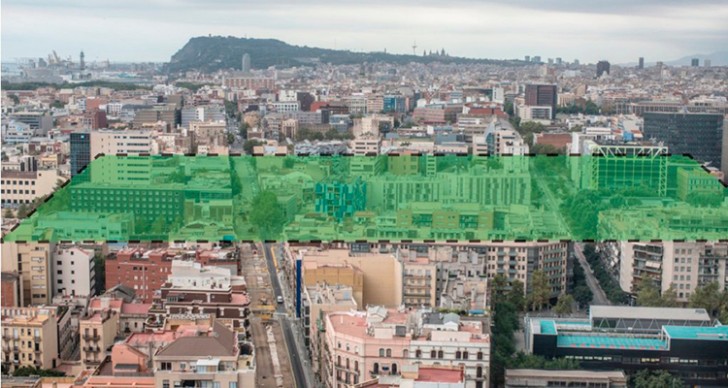In today’s post, we turn to the superblocks of Barcelona. Superblocks is an ambitious project of Barcelona’s city council to respond to the scarcity of green spaces, its high levels of pollution, environmental noise, accident rates and sedentarism.
Right now, there are just six superblocks, but Barcelona plans hundreds of others. Superblocks are basically made up of a grid of basic roads - nine existing blocks or some 400 by 400 meters to be exact. In the superblock area, all but essential vehicles are banned and the latter are limited to 10 km/h. The motorized traffic circulates in the exterior of the superblock. Perhaps the most ambitious goal of the project is to free up to 60% of the traffic area for public space and green infrastructure, create multifunctional ‘citizen spaces’ and tackle the urban heat island effect.
 Image source: http://www.bcnecologia.net/
Image source: http://www.bcnecologia.net/
Other cities have come toward as interested in replicating Barcelona’s superblocks.
The city of Seattle that has tried its hand in dramatically changing the neighborhoods before, has been one of the parties interested in following Barcelona’s example and design a
6-block pedestrian-and cyclist-first ‘superblock’ for Capitol Hill.
Even the
New York Times dedicated an article to the superblocks of Barcelona and how the plan could be applied in New York to redefine streets as public spaces.
Superblocks in Barcelona
As said above, there are currently six established superblocks have been drawn in the neighborhoods of Les Corts, Hostafrancs, L'Eixample, around Glòries and in Poblenou. The most mediatic one has definitely been the one in Poblenou, which opened in 2016.
Poblenou Superblock
¡In total, the “Poblenou Superblock” has increased public space for pedestrians by 13,350 square meters. In the inner streets, the number of vehicles circulating has dropped by 58%. These streets that once exceeded the WHO’s noise exposure limits have now five decibels lower noise levels. To make the neighborhood more welcoming for its residents, more than three hundred benches have been installed and 212 new trees planted.
However, there has also been some resistance to the project: some local residents and business people who considered it an endeavor that would undermine the neighborhood. All in all, controversy and discussions are also an important part of introducing innovative approaches.
There’s also a darker side to making a city greener since urban green boosterism is significantly correlated to unaffordability. To avoid gentrification, social housing or housing with some form of rent control is the only way. That’s also one of the reasons this concrete block in Poblenou was chosen: it is surrounded by a social housing project, meaning that the prizes won’t go up and people could still afford to live there.
Future of Superblocks
There are also
new pilot projects in development, one which will look at how to tackle sustainable energy by generating it from road surfaces, and the other focused on how the city's elderly population and how to help them through technology.
The main goal here is to make cities more inclusive for all citizens. We can analyze the data that cities collect to take more into account the groups who have been pushed into the background such as women, elderly or people with disabilities. It’s inevitable that the mobility pattern of different social and age groups varies and they must all be taken into account for inclusive urban development.
The
positive effect of superblocks on reducing air pollution, traffic noise and the temperature and increasing physical activity and green space, has also been discussed. Researchers concluded that d 667 premature deaths each year could be prevented by the introduction of planned 503 superblocks in Barcelona.
So all in all, superblocks are more than a trendy topic to talk about. Barcelona’s superblocks have been discussed and talked about all over the world and probably, soon enough, we will see the project grow.
Source: bcnuej.org
https://vimeo.com/282972390


 Image source: http://www.bcnecologia.net/
Image source: http://www.bcnecologia.net/